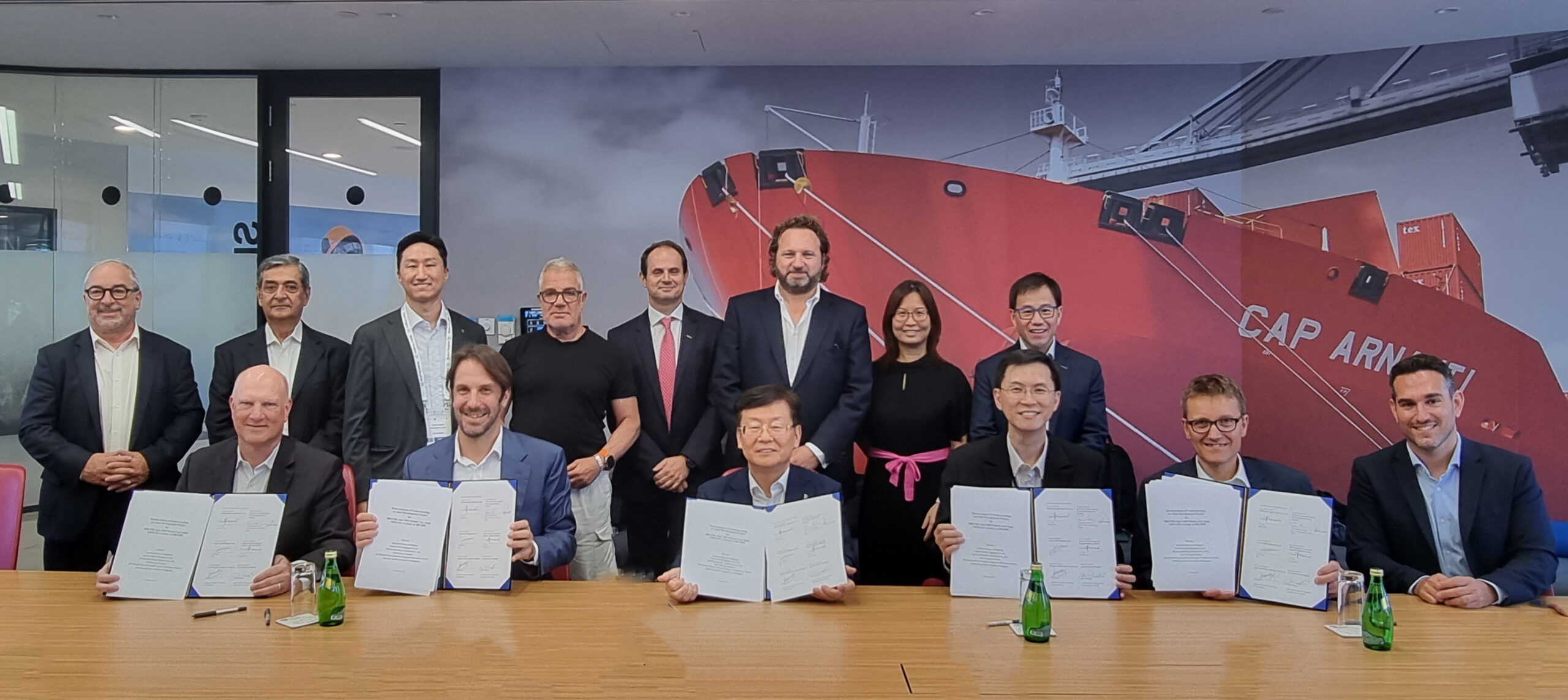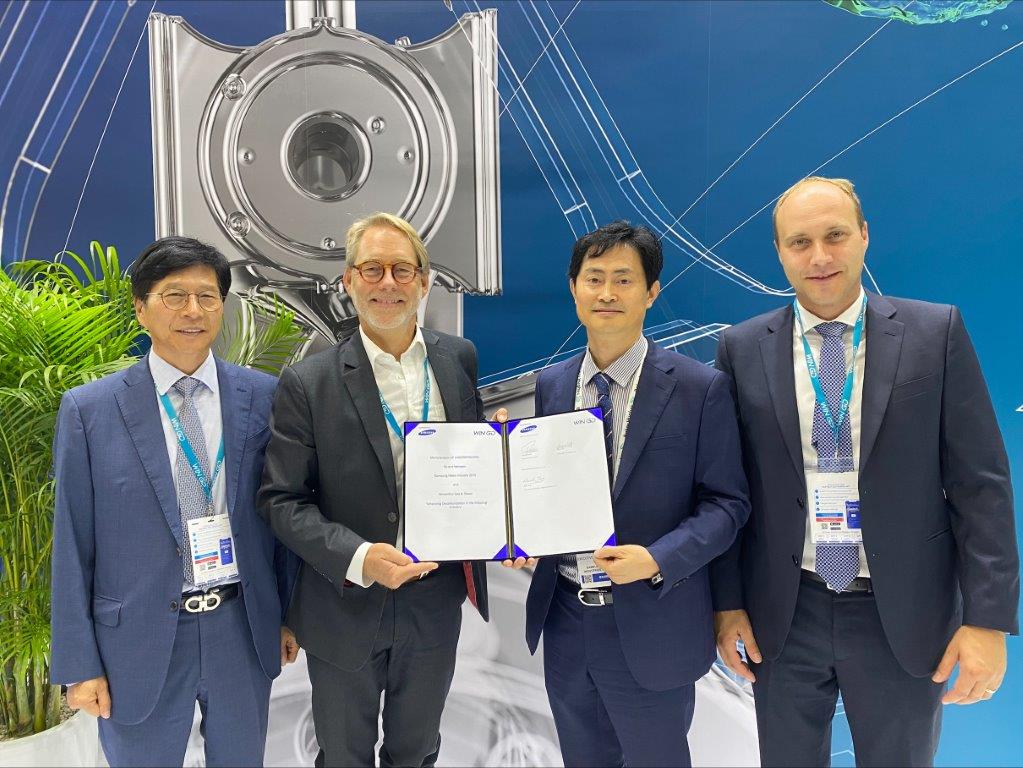Press Release: The Global Centre for Maritime Decarbonisation (GCMD) and its appointed consultant, DNV Maritime Advisory (DNV) supported by Surbana Jurong (SJ) and the Singapore Maritime Academy (SMA) at the Singapore Polytechnic (SP), have completed an ammonia bunkering safety study that was commissioned in January 2022. The risks identified for conducting pilots in the Port of Singapore were found to be low or mitigable, thus paving the way for a pilot project to take place at three identified sites.
Despite its toxicity and associated risks, green ammonia is one of the potential fuels that can decarbonise the shipping industry. With the completion of this study, local regulatory authorities will be able to use the report and its guidelines to deliberate the undertaking of an ammonia bunkering pilot. Because ammonia-fuelled vessels are not available today, ammonia transfers in the port waters of Singapore will be first carried out with ammonia carriers to ready stakeholders of the ecosystem for an actual bunkering pilot when ammonia-fuelled vessels are on the water.
A robust set of safety guidelines and operational envelopes
The 9-month-long study has resulted in a report titled “Safety and Operational Guidelines for Piloting Ammonia Bunkering in Singapore”. The study analysed capacity needs and feasible operating concepts; it recommends suitable sites for pilots, and identifies hazards, key risks and mitigation measures. The report also estimated the total capital expenditure for the additional infrastructure buildout needed to operationalise ammonia bunkering at two land-based sites.
For the study, the DNV consortium consulted extensively with 22 Study Partners and obtained feedback from more than 130 Industry and Consultation Alignment Panel (iCAP) members. Conversations with relevant regulators helped refined the analyses. Given the Port of Singapore’s proximity to dense residential areas and operations that see more than 1,000 ships a day, the stringent guidelines to pilot ammonia bunkering that were developed in this GCMD study will likely be applicable to piloting ammonia bunkering at ports elsewhere.
Safety risks can be mitigated
More than 400 potential risks were identified and assessed based on four technically feasible operational concepts: breakbulk and bunkering at anchorage, as well as shore-to-ship transfer and cross-dock transfer at two land-based sites for potential ammonia bunkering. The consortium found the identified risks to be manageable with mitigation measures. The analysis showed that individual fatality and injury risks depend on the flow rate of ammonia, the number of transfer operations, duration per transfer operation, and the length of piping and transfer arms.
Given the small number of ammonia bunkering pilots that would be carried out annually, the individual risks thresholds set by the Major Hazards Department of the Ministry of Manpower are not expected to be triggered. Coarse Quantitative Risk Assessment (QRA) using a deterministic dispersion model revealed a safety zone of 200 to 400 m for breakbulk and bunkering operations at anchorage with flowrates up to 700 cbm/hr.
Launching the ammonia report, Professor Lynn Loo, CEO of the Global Centre for Maritime Decarbonisation, said: “This report will inform and enable a GCMD pilot involving ship-to-ship transfer of ammonia in the port waters of Singapore. We are aiming for the first transfer of ammonia to take place by end 2023, subject to obtaining the greenlight from the relevant regulatory agencies. Since ammonia-fuelled vessels are not yet available, we will be conducting the pilot with proxy assets to gain stakeholder competence and confidence so an actual bunkering exercise can commence when ammonia-fuelled vessels are on the water.”
On the ammonia bunkering guidelines, Knut Ørbeck-Nilssen, CEO of DNV Maritime, said: “Ammonia holds potential for a future maritime fuel and thus one pathway for the maritime industry’s decarbonization journey. This project will help lay the safety considerations for ammonia bunkering. Safety lies at the heart of the guidelines that DNV helped to develop for this pilot in Singapore. Further pilots and studies are key to understand, assess and mitigate safety risks associated with using ammonia fuel onboard the world fleet.”
Tan Wooi Leong, Managing Director, Energy & Industrial, Surbana Jurong, said: “The study will bolster Singapore’s position as an innovative and responsible global maritime hub leader as it seeks to decarbonise the maritime industry. This study gives authorities a very practical, comprehensive view of the costs associated with designing a port that supports the safe transfer and storage of this toxic but game-changing alternative fuel.”
Beyond the study
In preparation for the next phase of the GCMD project to execute an ammonia bunkering pilot in Singapore, GCMD is working with SMA to operationalise the manpower development framework for training operators to handle ammonia as a marine fuel. Already, SMA has incorporated elements from the study to develop the first training course on the handling of ammonia under the International Code of Safety for Ships Using Gases or Other Low-flashpoint Fuels (IGF Code) and industry guidelines. This course took place for the first time in March 2023, and registration is open for its next intake.
Capt Chatur Wahyu, Acting Director of Singapore Maritime Academy (SMA), Singapore Polytechnic (SP) said: ”SMA had recently successfully conducted the Advanced IGF course where the topic on ammonia handling was covered during the programme. SMA is committed to contributing in the efforts towards green shipping and using ammonia as a future source of clean energy for the maritime industry. We hope to upskill more maritime talents to meet the needs of the industry’s changing landscape.”
GCMD is also working closely with Oil Spill Response Limited to develop emergency response procedures, and will be sharing the full report with the Singapore Standards Council to support the development of a technical reference on ammonia bunkering.
A public version of this report, with land-based site identity and site-specific information i.e., their specific operational risk analyses and infrastructure readiness, redacted for commercial sensitivity considerations, is openly available. Access the link to download the report.
The full report will be made widely available at a later date.
About the Global Centre for Maritime Decarbonisation
The Global Centre for Maritime Decarbonisation (GCMD) was set up on 1 August 2021 as a non profit organisation. Our strategic partners include the Maritime and Port Authority of Singapore (MPA), BHP, BW Group, Eastern Pacific Shipping, Foundation Det Norske Veritas, Ocean Network Express, Sembcorp Marine, bp and Hapag-Lloyd. Beyond the strategic partners, GCMD has brought onboard 13 partners that engage at the centre level, in addition to numerous other partners that engage at the project level.
Strategically located in Singapore, the world’s largest bunkering hub and second largest container port, GCMD aims to help the industry eliminate GHG emissions by shaping standards for future fuels, financing first-of-a-kind projects, and piloting low-carbon solutions in an end-to-end manner under real-world operations conditions. For more information, please visit www.gcformd.org.

































